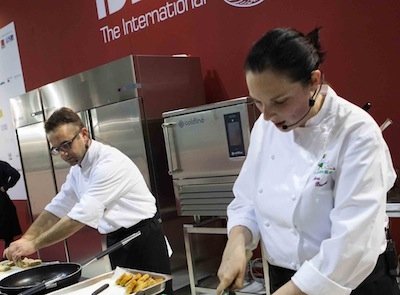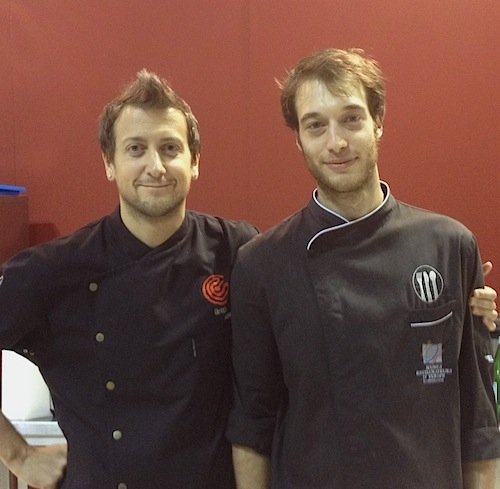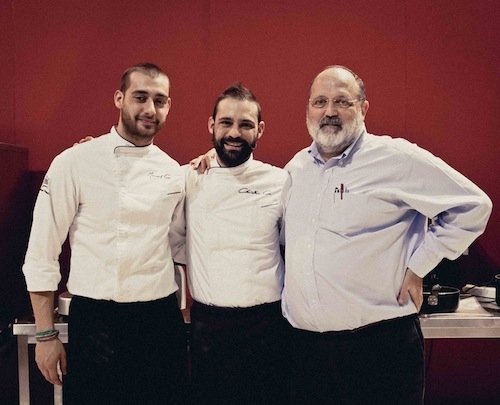Host, starts the fifth day with a happy return, namely that of Daniel Facen from Anteprima in Chiuduno (Bergamo). On his counter there’s a yellow object that looks like a drill but in fact is an ultrasonic tool, the chef from Trentino explains: «With 24thousand pulses per second, it shatters the cells and arrives to the core of the ingredient. If you use it, there’s no need to use additives or amides to thicken sauces. Take this scallop, after the pulses the taste is 40% stronger». True.
Sea urchins, on the other hand, become white and not red: «We leave it in an evaporator at 33°C. We serve it with caviar and passion fruit». This is a simple dish but with a very intense concept. These technologies are also a direct reflex of Facen’s passion for medical studies: «The use of ultrasounds in the kitchen occurred to me when I realised that in the hospital, in order to cure third-degree burns, they use them to let the dead cells come to surface, something which accelerates the birth of new healthy cells».

Sara Preceruti and Sabino Andrea Luisi, chef and sous chef of Locanda del Notaio in Pellio Intelvi (Como)
Once again it’s the turn of
Sara Preceruti, from Pavia but now working in Pellio Intelvi, Como. After lamb, today it’s time for the dessert. It is called
Pazzia atto secondo (literally Madness second act) and it is the evolution of a dessert called
La Pazzia, which in its first version also included some tomato jam and a liquorish ice-cream. This time the base is made with custard, aromatised with nutmeg, yogurt ice-cream, a cocoa wafer and a surprising courgette mousse, which is syphoned at the end, using only the green part of the vegetable. A delicious
Pazzia for which the ingredients are not listed in the menu, «otherwise someone might turn up their nose, when reading there’s a courgette among the desserts». When we tasted it, it was perfectly in tune.
Christian Milone is back. The ex-athlete is now ready to cook even for 10 tables, after the training that for two years saw him serving no more than 2 tables in the kitchen of Trattoria Zappatori’s Gastronavicella in Pinerolo (Torino). In Rho, with his trusted Lorenzo Cocchi, he prepares Chicken breast with bay leaves and mandarin «but not one of those that get stuck in your mouth». The low temperature in fact guarantees a beautiful softness. In addition, there’s the sweet-sour flavour of the extra virgin olive oil milled with mandarins, the vegetal note of the bay leaves and the salad and the delicate spiciness of the mustard, both Italian and Japanese (mizuna), a heritage of his now notorious internship with Enrico Crippa.

Christian Milone and Lorenzo Cocchi of Gastronavicella at Trattoria Zappatori in Pinerolo (Torino)
We noted down three interesting sentences. First: «Roner is just an evolution of bain-marie». Second: «With low temperature cooking you don’t necessarily need to follow the suggested duration. In fact, the chef should know when to stop or prolong the cooking depending on the state in which the animal arrives». Third: «When it is good, meat doesn’t need a side dis. The same goes for vegetables: if they are good, they can’t act as bridesmaids».
Finally, after a long time, it is the first time that we see the
Costardi brothers not at work with a risotto. Their first dish is a tribute-sandwich dedicated to Pizzarrosto, a village near Vercelli famous for the water activities on river Sesia. Except it is perfected: there’s a highly digestible fresh focaccia, the typical green sauce served with Piedmontese boiled meat (with Timorasso vinegar), a red sauce, onion and vacuum cooked tongue (thus very tender). A «lurid» sandwich, it’s been said.

Manuel and Christian Costardi of Cinzia in Vercelli with Paolo Marchi
The second is a
Tribute to Picasso: desalted salted-codfish, put in a vacuum pack with garlic and rosemary and oil and then left in the Roner at 70°C for 6-7 minutes. The reference is to the (short) pink period of the painter: the base is made with a pink Tropea onion cream, which welcomes the processed codfish. No salt is added.